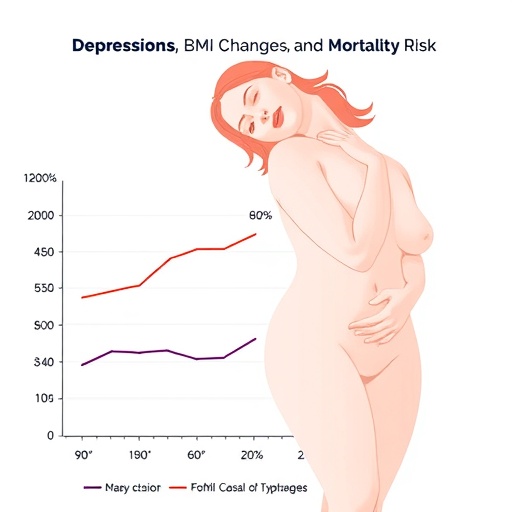In a groundbreaking population-based study published in BMC Psychiatry, researchers have unveiled complex interactions between depressive symptoms, patterns of body mass index (BMI) changes throughout adulthood, and the subsequent risk of all-cause mortality. The investigation leverages over a decade’s worth of data from the National Health and Nutrition Examination Survey (NHANES) collected between 2007 and 2018, shedding new light on how longitudinal BMI trajectories may not only reflect physical health but also significantly impact mental well-being and mortality outcomes.
The research team, led by Xu, Chen, and Lei, identifies that dynamic changes in BMI during adulthood play an underappreciated yet critical role in the etiology of depression. Unlike prior studies that predominantly focus on static BMI measurements, this study parses individuals into distinct BMI change patterns—most notably highlighting the “high-increase” group, whose BMI rises markedly over time. It is within this group that the odds of experiencing depressive symptoms increase substantially, with an adjusted odds ratio of 1.61 relative to those maintaining a non-overweight BMI profile.
Diving deeply into the mental health assessment, depressive symptoms were quantified using the Patient Health Questionnaire-9 (PHQ-9), a globally recognized instrument validated for both screening and severity evaluation of depression. The analysis confirms that individuals with intensified PHQ-9 scores not only face significantly higher burdens of mental distress but also demonstrate elevated mortality risks. The hazard ratio for all-cause mortality associated with PHQ-9 scores stood at 1.03 after adjustments, pointing to a modest yet significant association between depressive symptom severity and survival outcomes.
Crucially, the study employs Cox proportional hazards models and Kaplan-Meier survival curves to visually and statistically capture temporal trends in mortality risk stratified by BMI change categories and depressive symptomatology. These methodological advances enable a nuanced perspective that moves beyond cross-sectional associations, enabling the detection of temporal interplay and mediatory relationships.
Perhaps the most compelling revelation emerges from the mediation analysis, which quantifies the degree to which BMI change patterns account for the link between depressive symptoms and mortality. This analytic approach demonstrates that nearly 27% of the mortality risk associated with depression can be explained through BMI trajectories experienced during adulthood. Such mediation underscores the multidimensional intersections between metabolic health, psychological states, and mortality risk pathways.
The implications of these findings are profound for clinicians and public health strategists alike. Persistent obesity—a prevalent and often overlooked chronic condition—clearly amplifies susceptibility to depression, which in turn is closely tied to lifespan diminution. Interventions targeting safe and sustainable BMI management could, therefore, double as mental health interventions, reducing the burden of depression through physiological pathways while potentially extending life expectancy.
Moreover, the study highlights differential impacts by gender and age, suggesting the necessity for tailored strategies that account for demographic variability in the BMI-depression-mortality nexus. Such stratification may refine screening protocols, enabling prioritization of high-risk groups for timely and focused preventative care.
Despite these promising insights, the authors caution that the pathways linking BMI patterns and depression remain intricate and multifactorial. Biological mechanisms may involve inflammatory mediators, hormonal disruptions, and neuroendocrine alterations driven by adiposity fluctuations. Psychological factors, including body image perceptions and social stigma related to weight changes, likely exacerbate vulnerability to depression, creating feedback loops that complicate straightforward causal interpretations.
Future research avenues advocated by the investigators include interventional trials capable of modulating BMI trajectories to evaluate direct effects on depression incidence and mortality. Longitudinal designs incorporating repeated measures of psychiatric evaluations alongside metabolic biomarkers will be essential to unraveling causality and identifying actionable targets.
In a broader societal context, this study serves as a clarion call emphasizing the importance of integrating physical and mental health paradigms rather than treating them in isolation. Public health initiatives might benefit from adopting holistic frameworks addressing nutrition, physical activity, and psychosocial support concurrently, particularly across vulnerable adult populations experiencing changing body mass profiles.
Experts anticipate that this groundbreaking work will fuel a paradigm shift in how clinicians approach the complex web of depression and metabolic health, driving innovations in precision medicine. By harnessing big data analytics and epidemiological rigor, the nuanced understanding of how BMI trajectories influence mental health and mortality risk could stimulate development of multifaceted treatment guidelines incorporating psychological assessments within traditional metabolic risk management.
As evidenced by this study’s rigor and scope, leveraging large-scale datasets like NHANES provides critical leverage points to decode hidden health interrelations at the population level. The investigation’s blend of advanced statistical techniques, including logistic regressions, generalized linear models, and mediation analyses, exemplifies a sophisticated approach to epidemiology that can serve as a template for future multifactorial health studies.
Ultimately, the study by Xu and colleagues delivers compelling evidence that adult BMI change patterns are not mere reflections of lifestyle but active, mediating agents in the dynamic interplay of depression and mortality. The identification of these pathways opens transformative opportunities for intervention design oriented towards reducing both the psychological burden and premature deaths related to obesity-linked depression.
As the global burden of depression continues to escalate alongside rising obesity rates, this integrative analysis offers a beacon of hope to advance prevention strategies. Stakeholders across healthcare systems, policymakers, and researchers are encouraged to heed these findings and foster comprehensive approaches that transcend singular disease silos, enhancing lifelong health trajectories and wellbeing.
—
Subject of Research: The relationships between depressive symptoms, adult body mass index change patterns, and all-cause mortality risk.
Article Title: The interplay between depressive symptoms, body mass index change patterns in adulthood, and all-cause mortality risk: a population-based study
Article References:
Xu, Z., Chen, C. & Lei, X. The interplay between depressive symptoms, body mass index change patterns in adulthood, and all-cause mortality risk: a population-based study.
BMC Psychiatry 25, 479 (2025). https://doi.org/10.1186/s12888-025-06924-y
Image Credits: AI Generated
DOI: https://doi.org/10.1186/s12888-025-06924-y




